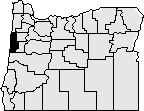
Lincoln County was created by the Legislative Assembly Feb. 20, 1893, from the western portion of Benton County and Polk County. There were boundary adjustments and annexations in 1923, 1925, 1927, 1931, and 1949. The county is bordered by Tillamook County on the north, Polk and Benton Counties on the east, Lane County on the south, and the Pacific Ocean on the west. It covers 992 square miles. The county was named for President Abraham Lincoln.
When Lincoln County was formed, Toledo was picked as the temporary county seat. In 1896 it was chosen as the permanent county seat. In 1897 there was agitation to build a county courthouse and with the growing demand a courthouse was finally built in 1899. The city jail of Toledo was also made the official county jail that same year. In 1913 a new county jail was built. Three elections were held to determine if the county seat should be moved from Toledo to Newport. Twice these votes failed in 1928 and 1938. But, in 1954 the vote went in Newport's favor. While Toledo has remained the industrial hub of Lincoln County, the city has never regained the position it once had.
Lincoln County was governed by a commissioner's court, which consisted of two commissioners and a county judge. The court started meeting in April 1893, in a rented building in Toledo. Appointed officials were the sheriff, stock inspector, school superintendent, coroner, county court judge, treasurer, veterinarian, and clerk. The county court was replaced by a three member board of commissioners in the late 1960s.
The 1900 census measured Lincoln County's population at 3,575. By 2013, it had grown to 46,560 representing an increase of 1.1% over 2010.
The northern part of Lincoln County includes the Siletz Indian Reservation which was created by treaty in 1855. The reservation was opened to white settlement in 1895 and closed to white settlement by the federal government in 1925. The Siletz's tribal status was terminated by the federal government in 1954. In 1977 the Siletz became the first Oregon tribe to have their tribal status reinstated. The current reservation totals 15,204 acres.
The Coast Highway, completed in 1925, and the Salmon River Highway completed in 1930, improved inland transportation. In 1936 as part of federally funded construction projects, bridges were constructed across the bays at Waldport, Newport, and Siletz thus eliminating the ferries that had formerly traversed these bays. A 1910 election created the ports of Toledo, Newport, and Alsea.
Principal industries of the county are tourism, fishing, trade, and construction. Newport is Oregon's oceanography research center as the home of Oregon State University's Marine Science Center, the Oregon Coast Aquarium, and the National Oceanic and Atmospheric Administration (NOAA) Marine Operations Center-Pacific.